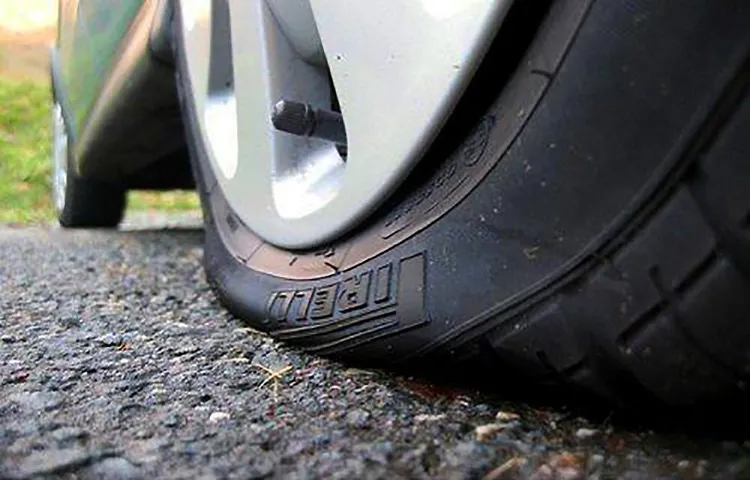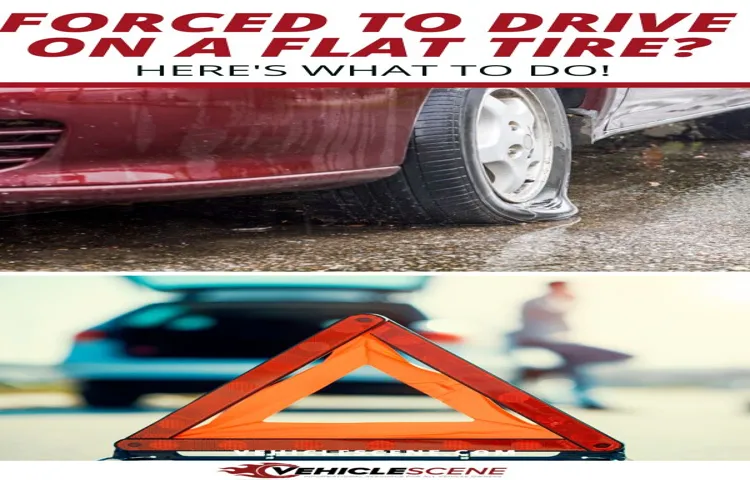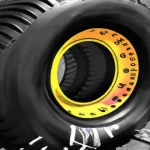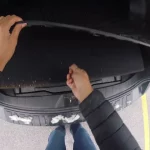When you’re driving on a bridge or through a tunnel, the last thing you want is a flat tire. It can be an intimidating and potentially dangerous situation, but it’s important to stay calm and take the necessary steps to stay safe. So, what should you do if you find yourself with a flat tire in a tunnel or on a bridge? First and foremost, don’t panic.
While it’s understandable to feel nervous or anxious in this situation, it’s important to remain calm so you can make clear decisions. If possible, try to move your vehicle to the side of the road or a safe area, as far away from traffic as possible. Turn on your blinkers and emergency hazard lights to signal to other drivers that there’s an issue.
Next, assess the situation. Do you have a spare tire and the necessary tools to change it? If not, you may need to call for roadside assistance. If you do have the tools and knowledge to change the tire, be sure to follow all safety precautions and work as quickly and efficiently as possible.
One thing to keep in mind is that changing a tire on a bridge or in a tunnel can be more challenging than on a regular road. Ensure that your vehicle is securely parked before beginning, and if necessary, place flares or warning triangles around your vehicle to increase visibility. Overall, dealing with a flat tire in a tunnel or on a bridge requires a cool head and a focus on safety.
By taking the necessary precautions and remaining calm, you can successfully navigate this situation and keep yourself and others safe on the road.
Table of Contents
Assess the situation
Getting a flat tire is never a good experience, but it can be even more stressful if it happens in a tunnel or on a bridge. If you find yourself in this situation, the first thing to do is to assess the situation. Find a safe place to pull over if possible, away from traffic and as far from the edge of the road as you can.
Turn on your hazard lights to alert other drivers. If you’re on a bridge with little or no shoulder, it might not be safe to change your tire until you can get off the bridge. In this case, call for help and wait for assistance.
It’s better to be safe than sorry, and risking your safety or the safety of others is not worth trying to change a flat tire on your own. Remember, safety should always come first, so stay calm, assess the situation, and call for help if necessary.
Check if you can safely move to the side of the road
When you find yourself in a situation where your car is not working or has a mechanical issue, it’s important to assess your surroundings before attempting to move to the side of the road. First, check if you have enough space on the side of the road to move your car safely out of the way of other drivers. Look for any nearby hazards, such as sharp turns or steep drops, which could make it hazardous to pull over.
If your car is still drivable, try to find a spot with enough space to park your car without blocking traffic or endangering yourself or others. Remember, safety comes first, so always make sure you can safely move to the side of the road before trying to fix your car or call for assistance. By assessing the situation and taking necessary precautions, you can avoid potential accidents or injuries, and make the best decision for your safety and that of other road users.

Put on your hazard lights to alert other drivers
When you find yourself in a tricky situation while driving, the first thing you should do is assess the situation. Take a moment to determine what caused the issue before taking any action. Once you’ve identified the problem, consider turning on your hazard lights to alert nearby drivers.
This can help prevent any further accidents and provide a clear warning to other drivers on the road. Your hazard lights can also indicate to other drivers that you are in need of assistance. Remember to use this feature carefully and responsibly as it can be confusing for drivers if used at the wrong time.
Put yourself in the shoes of other drivers, and use your hazard lights only when necessary. By doing so, you can ensure your safety and the safety of others on the road. So, whenever you face a challenging situation while driving, remember to assess the situation and use your hazard lights if necessary.
Stay safe on the road.
Listen for traffic updates on your radio or phone
When you’re traveling on the road, it’s important to stay aware of the traffic situation in your area. One of the best ways to do this is to listen to your radio or phone for traffic updates. By staying informed, you can make better decisions about your route and potentially avoid delays or accidents.
However, it’s also important to assess the situation yourself to make sure you’re taking the most appropriate action. For example, if you hear about a traffic jam ahead, it’s worth checking whether there’s a detour available or whether you should wait it out. By combining the information you get from traffic updates with your own common sense, you can ensure that you stay safe on the road.
So next time you’re driving, remember to tune in and assess the situation for a smoother, stress-free journey.
Stay Safe
It’s never a pleasant experience getting a flat tire while driving, let alone if it happens in a tunnel or on a bridge. The first thing you should do in such a situation is to keep calm and avoid panicking. If you’re on a bridge, try to see if there’s a shoulder or space where you can safely pull over.
If there’s no shoulder, try to slowly drive to the nearest exit or safe area. In a tunnel, you should pull your vehicle over to the side of the road as far as possible and turn on your hazard lights. Next, assess the situation and determine if you can change the tire yourself or if you need help.
If you can change the tire, make sure you have all necessary equipment and follow proper safety procedures. If you need assistance, call for help immediately and stay inside your vehicle until help arrives. Remember, safety should always be your top priority in situations like this.
Stay inside your vehicle if possible
When traveling on the road, unexpected situations can arise at any given moment. One common challenge for drivers is dealing with severe weather conditions. As much as possible, you should stay inside your vehicle if you come across extreme weather conditions, such as a blizzard or a hailstorm.
It may be tempting to get out and brave the elements, but doing so can be dangerous and even life-threatening. Staying inside your car will offer you a degree of protection from the harsh weather outside. Besides, being inside your vehicle gives you a better chance of being visible to rescue crews, especially if it’s snowing or foggy outside.
To improve your safety further, ensure that you’ve got plenty of gas in your car’s tank, have a fully charged phone with you, and carry warm blankets and food. All of these can help you stay safe and comfortable until help arrives. Remember, staying inside your vehicle can make a significant difference in your safety and ensuring you get through severe weather conditions unscathed.
If you need to get out, do it on the passenger side
In order to stay safe while exiting your vehicle, it’s important to remember to always get out on the passenger side if possible. Not only does this lessen the risk of getting hit by passing traffic, it also gives you more visibility of your surroundings before stepping out. Of course, there may be situations where this isn’t possible, such as if you’re parked on a busy road or if the passenger side is blocked.
In these cases, it’s important to take extra precautions and be extra aware of your surroundings before opening your door and stepping out. This could mean checking your mirrors and blind spots multiple times, or waiting for a break in traffic before making your move. By following these simple steps, you can help ensure your safety and avoid any unnecessary accidents.
Call for help and give your location
When in an emergency situation, it’s crucial to stay safe and call for help as soon as possible. One of the most important things to do is to give your location so that emergency responders can find you quickly. Whether you’re lost in the wilderness or experiencing a medical emergency, it’s essential to remain calm and clear-headed when calling for help.
If possible, provide as many details about your location as you can, such as nearby landmarks or street signs. If you don’t know your location, try to find any identifying features that could help rescue crews locate you. Remember, the faster help can find you, the higher your chances are of surviving.
So, don’t hesitate to call for help and ensure that you give your location accurately.
Repair or Replace
Getting a flat tire can be a stressful experience, but it’s even more daunting when it happens in a tunnel or on a bridge. The first thing you should do is try to move your car out of the way of other vehicles to avoid causing an accident. If there is no shoulder or safe area to move your car, turn on your hazard lights and stay in your vehicle until help arrives.
In terms of repairing or replacing the tire, it’s always best to have a spare tire on hand and change the flat tire yourself if possible. If you don’t have a spare or are unable to change the tire, calling for roadside assistance is the next best option. When driving on bridges or in tunnels, it’s essential to pay attention and be prepared for any sudden changes such as a flat tire.
Always carry a spare tire, make sure your car is well-maintained, and have a plan in place for emergencies.
If you have a spare tire, attempt to change it yourself if it is safe to do so
If you find yourself on the side of the road with a flat tire and a spare tire, it’s worth considering changing it yourself if you feel confident doing so. However, it’s important to remember that safety should be your top priority. Before attempting to replace the tire, make sure you’re in a safe location, away from other drivers and traffic.
Once you’ve determined your location is safe, assess the condition of the spare tire. If it’s outdated or damaged, you may need to consider getting it repaired or replacing it altogether. Take the time to familiarize yourself with the tools needed to change the tire, including the wheel wrench and jack.
Remember to never place yourself in a position where the vehicle could fall, and always use the jack on a flat, stable surface. By taking these precautions and utilizing your spare tire safely, you can tackle the challenge of changing a flat tire with confidence.
If you’re unable to change the tire, wait for a tow truck or roadside assistance
When it comes to dealing with a flat tire, there are two options: repair or replace. In most cases, a small puncture can be repaired relatively easily, but if the damage is too severe, replacement may be necessary. If you notice a flat tire while driving, the first step is to find a safe place to pull over.
Keeping your safety in mind, it’s best to move as far off the road as possible. Once you’ve stopped, assess the tire to determine whether it can be repaired or if it needs to be replaced. If the puncture is small, it may be possible to repair it using a patch kit.
However, if the tire is severely damaged or has a puncture on its sidewall, it must be replaced. Additionally, if you’re unable to change the tire yourself, don’t hesitate to call for roadside assistance or a tow truck. Safety should always come first, and it’s better to wait a little while longer for assistance than risk injury trying to change your tire alone.
So, if you’ve got a flat tire, take a deep breath, evaluate the damage, and decide whether repair or replacement is your best option.
Prevention tips
Getting a flat tire can be an unsettling experience, especially if it happens on a bridge or in a tunnel. Fortunately, there are some prevention tips that could help you avoid this unfortunate situation. The first thing you should do is to inspect your tire pressure regularly and ensure that it’s at the right level.
This is essential as underinflated tires are more likely to get punctured. Secondly, you should check the condition of your tires and replace them if they’re worn out. Balding tires are more prone to punctures and blowouts.
Thirdly, avoid overloading your vehicle as this could put excessive stress on your tires and increase the risk of a blowout. Lastly, it’s wise to avoid hitting potholes and other debris on the road as they could damage your tires. By following these simple tips, you can reduce your chances of getting a flat tire and stay safe while driving on bridges and tunnels.
Regularly check your tire pressure and condition
Checking your tire pressure and condition regularly is one of the easiest and most important ways to prevent accidents while driving. Maintaining the correct tire pressure can improve your vehicle’s fuel efficiency, handling, and overall safety. Ensure that you check your tire pressure at least once a month, and always before any long road trips.
You can find the recommended PSI (pounds per square inch) for your vehicle in the owner’s manual or on the inside of the driver’s side door. Additionally, inspect your tires for any signs of wear and tear, such as punctures, cracks, or bulges. If you notice any damage or excessive wear, take your vehicle to a professional for further inspection.
By staying on top of your tire maintenance, you can avoid unexpected tire failures and enjoy a safer, smoother ride on the road.
Have a spare tire and tools on hand
Having a spare tire and tools on hand is crucial for any driver. It can save you from being stranded on the side of the road or prevent a potential accident. Prevention is key to ensure your safety while driving.
You never know when you might encounter a flat tire or a broken belt. That’s why keeping a spare tire, lug wrench, jack, and tire iron in your trunk can make all the difference. Make sure to check your spare tire’s condition and pressure regularly too.
If you’re not sure how to change a tire, it’s essential to learn how to do it before hitting the road. You can also carry a tire sealant and inflator kit that can quickly repair punctured tires. However, it is only a temporary fix, and it would be best to get the tire checked by a professional as soon as possible.
Not only does having a spare tire and tools on hand save you time and money, but it can also give you peace of mind. By taking preventative measures, you can keep yourself safe and avoid additional hazards on the road. Remember, safety starts with you, and taking the necessary precautions can be the difference between a minor inconvenience and a severe incident.
In conclusion, being prepared is always better than being caught off guard. Check your tires regularly, and always have a spare tire and tools on hand. Knowing how to change a tire and having a tire repair kit can save you time, money, and potentially prevent an accident.
So, stay safe, be prepared, and hit the road knowing you’re ready for whatever comes your way.
Consider getting run-flat tires
As a car owner, you want to do everything you can to avoid getting stranded on the side of the road with a flat tire. One way to accomplish this is by investing in run-flat tires. These specialized tires feature tough, reinforced sidewalls that can continue to support the weight of your vehicle even after a puncture.
With run-flat tires, you can continue driving for up to 50 miles at reduced speeds, giving you ample time to safely reach your destination or a repair shop. While run-flat tires may cost more upfront, they can provide peace of mind and potentially save you from a much more expensive and inconvenient situation in the long run. Consider getting run-flat tires if you frequently travel long distances or tend to drive in remote areas with limited access to assistance.
It’s always better to be prepared and avoid unnecessary worry.
Drive cautiously on bridges and tunnels to avoid potholes or debris
While driving on a bridge or through a tunnel, it’s important to be extra cautious and aware of the road conditions. Potholes and debris can be found on these structures, which could lead to potential damage to your vehicle or even a dangerous accident. To prevent such incidents, always keep your speed limit in check and maintain a safe distance from other vehicles ahead of you.
It’s also important to keep an eye out for any signs of potholes or debris, and if possible, try to avoid them by changing lanes or slowing down. Remember, prevention is always better than cure, and by being aware and attentive, you can help avoid any unforeseen incidents on bridges and tunnels. So the next time you’re driving on one, keep an eye out, and prioritize safety over speed.
Conclusion
In the wise words of the great philosopher, Beyoncé, “If you liked it then you shoulda put a spare on it.” If you find yourself with a flat tire on a bridge or in a tunnel, stay calm, turn on your hazard lights, and follow proper safety protocols. But let’s be real, why risk getting stranded when putting a spare tire on before hitting the road can save you a headache later? So don’t be caught unprepared, take the extra step and “put a spare on it.
” Your future self will thank you.”
FAQs
What is the first thing you should do if you get a flat tire in a tunnel or on a bridge?
The first thing you should do is turn on your hazard lights to alert other drivers to slow down and be cautious.
Is it okay to continue driving on a flat tire in a tunnel or on a bridge?
No, it is not safe to continue driving on a flat tire. Pull over to a safe location as soon as possible.
How do you safely change a flat tire on a bridge or in a tunnel?
Follow the same procedures as changing a tire on any other road. Pull over to a safe location, turn on your hazard lights, and place cones or flares behind your vehicle if possible.
What if you cannot safely pull over to change your flat tire in a tunnel or on a bridge?
Stay in your vehicle with your seatbelt on and wait for emergency services to arrive. They will have the proper equipment to safely change your tire.
Should you try to fix your flat tire yourself in a tunnel or on a bridge?
No, it is not safe to try and fix your tire yourself in a tunnel or on a bridge. Wait for emergency services to arrive.
Can you call a tow truck to help with a flat tire in a tunnel or on a bridge?
Yes, you can call a tow truck to safely remove your vehicle from the dangerous location and take it to a nearby repair shop for a tire change.
Are there any precautions you can take to avoid a flat tire on a bridge or in a tunnel?
Always make sure your tires are properly inflated, check for signs of wear or damage regularly, and avoid driving over potholes or other obstacles on the road.



